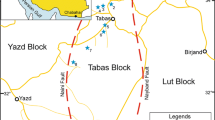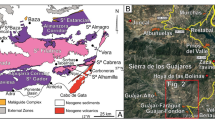Abstract
The Dahlak archipelago is part of a carbonate shelf, separated from the Eritrean coast by the Massawa Channel, where present-day carbonate sediments accumulate on and around uplifted blocks of Pleistocene ‘Dahlak Reef Limestone’. They are the uppermost part (about 100 m thick) of a shallow-water sedimentary complex, that overlies an evaporite sequence of Miocene age with a measured maximum thickness of over 3000 m. The physiography of the Dahlak Reef Limestone outcropping on the islands and also that of present-day depositional environments are related to recent, still active, tectonic movements and recent sea- level changes. The complex sea-floor topography prevents the development of any organized facies belts from the inner shelf to the outer margin. Widespread records of a late Holocene higher sea-level are found all around the archipelago: fossil wave-cut notches 1–3 m above present sea level; dried-up intra-island lagoonal areas; upward shoaling subsurface sequences in sabkha and lagoonal areas; moribund or dead fringing reefs; palimpsest character of many bioclastic sediments.
Structural features and sedimentary facies distribution divide the Dahlak shelf into two main units: a north-west unit, including islands and islets east of the North Massawa Channel, the largest of which is Harat; and a south-east unit, including the large island of Dahlak Kebir and, to the east, the Dahlak Bank.
In the north-western unit, the distribution of depositional facies is closely related to a tectonic pattern which originated from the intersection of fault systems, including the Danakil Rift and ring-like fault systems at the edges of bathymétric depressions resulting from the collapse of the cover rocks due to mobilization or near- surface dissolution of salt domes.
Present-day sedimentation is controlled by three major morpho-structural features:
-
1.
Emerging structural highs, forming a number of islands, islets and rocks, sometimes with intra-island lagoons, mangrove swamps and wide supratidal flats which, in places, pass into sabkhas.
-
2.
Shallow submerged structural highs, with flat tops and separated from surrounding deeper floors by step faults.
-
3.
Deep structural lows, arranged in troughs and ovoid depressions characterized by muddy sedimentation, with abundant faecal pellets and assemblages of pteropods, planktonic foraminifers and calcareous nanoplankton.
The south-eastern unit, informally named Dahlak Kebir shelf, consists of a large uplifted block of Dahlak Reef Limestone, bordered westward by the deep narrow tectonic trough of the South Massawa Channel and eastward by the steep edge of the axial trough of the Red Sea. Along the south-western edge of this shelf sedimentation is influenced by the largest island of the archipelago and also by a system of step faults, oriented north-west-south-east parallel to the axis of the Massawa Channel and by a series of deep troughs with predominantly muddy sediments. The eastern sector of the shelf, particularly the Dahlak Bank area, is a wide, shallow-water plateau consisting of emergent flattened Pleistocene coral reefs and several shoals, composed of storm-thrown, coarse, carbonate sand and coral debris.
Access this chapter
Tax calculation will be finalised at checkout
Purchases are for personal use only
Preview
Unable to display preview. Download preview PDF.
Similar content being viewed by others
Editor information
Editors and Affiliations
Rights and permissions
Copyright information
© 1998 Springer Science+Business Media Dordrecht
About this chapter
Cite this chapter
Carbone, F., Matteucci, R., Angelucci, A. (1998). Present-day sedimentation on the carbonate platform of the Dahlak Islands, Eritrea. In: Purser, B.H., Bosence, D.W.J. (eds) Sedimentation and Tectonics in Rift Basins Red Sea:- Gulf of Aden. Springer, Dordrecht. https://doi.org/10.1007/978-94-011-4930-3_28
Download citation
DOI: https://doi.org/10.1007/978-94-011-4930-3_28
Publisher Name: Springer, Dordrecht
Print ISBN: 978-94-010-6068-4
Online ISBN: 978-94-011-4930-3
eBook Packages: Springer Book Archive




